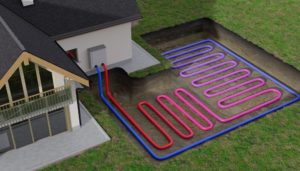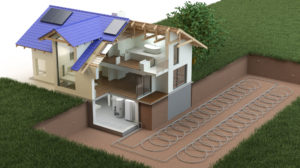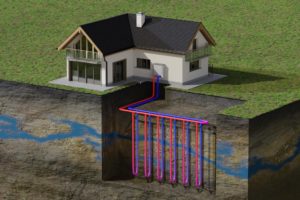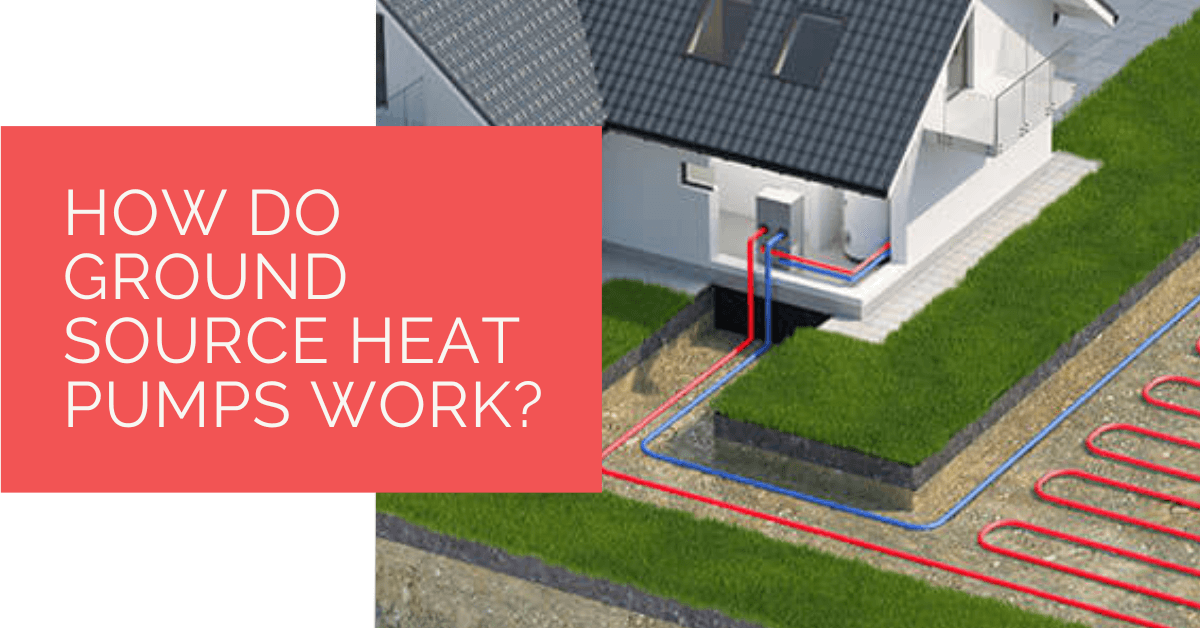Have you ever been curious about the functioning of ground source heat pumps?
Ground Source heat pumps absorb natural heat from the ground and transfer this heat to the buildings needing heating and hot water. They have high energy efficiency as they have low carbon emissions.
The tasks performed by a boiler and the pump are the same except for one difference: The pump uses ambient ground heat while the boiler burns fuel to generate heat.
Ground source heat pumps are of daily use in typical households, so it is worth knowing exactly how they work. This article will introduce you to the basics of the workings of this system.
Contents
- 1 Key Takeaways
- 2 Components of Ground Source Heat Pumps
- 3 Things to Know Before Buying
- 4 How to Install a Ground Source Heat Pump
- 5 Changes in Heat-Powered Systems
- 6 Get the Best from Your Ground Source Heat Pump
- 7 Designing and Operating Your Heat Pump System
- 8 Environmentally Friendly Renewable Energy
- 9 Economical
- 10 Heat Pump Source: Reliable Heating and Cooling Solutions
- 11 Final Say
Key Takeaways
- Ground source heat pumps work by absorbing natural heat from the ground and transferring it to buildings for heating and hot water, offering high energy efficiency with low carbon emissions.
- Installation requires a significant amount of space, with the size depending on your home’s needs, and they can be used in conjunction with other heating systems like air source heat pumps.
- Ground source heat pumps are environmentally friendly and eligible for incentives like the Boiler Upgrade Scheme, offering cost-effective, long-term heating solutions that reduce carbon emissions.
Components of Ground Source Heat Pumps
Ground source heat pumps consist of two parts:
- A ground loop which is a network of buried water pipes
- A heat pump that is present on the ground level
Running a mixture of water and antifreeze around the ground loop extracts the heat stored in the ground. The mixture absorbs the underground heat and is ready for the next step in the process.
The following process is the compression of this mixture which goes through the heat exchanger. After extracting heat from the mixture, the heat exchange transfers the mix to a heating pump. Finally, the heat is ready to be transferred into your home’s central heating system.

Things to Know Before Buying
How Much Space Do You Need?
Installation of a ground source heat pump needs a large area of space. It means you will need a garden or a backyard with room for the digging machinery. Although the exact amount of space depends on two facts:
- How big is your home
- How much heat do you require daily
Is the ground source heating warm enough for you?
The electricity usage depends on how hot you need your water to be. Although the standard way a ground source heat pump works is by increasing the groundwater temperature by around 50 degrees Celsius.
According to your requirement, you can use a different backup heating system. You can also use an air source heat pump for additional heating. The air source heating device can be placed near your house with an open space to absorb heat from the surrounding air.
The Efficiency of Ground Source Heat Pumps
The ground source heat pump derives energy from a natural source- the ground. This can help you lower your carbon footprint. Replacing old coal or electric heating systems with ground source heat pump systems is wise as it will help you save considerable carbon.
As mentioned above, the heat pump requires another power source, usually running on electricity if you need additional heat. So it is not like the resulting CO2 emission will be negligible for everyone.
The energy saving trust also recommends using ground source heat pumps and shows that they can reduce CO2 emissions by up to 12 tonnes per year and reduce yearly billings by up to 3600 pounds.
How to Install a Ground Source Heat Pump
If you have decided to install ground source heat pumps, you must know that you need an accredited professional to complete the work. You must go through the Microgeneration Certification Scheme (MCS) installer to correct the outcome.
Moreover, you must follow a list of rules to ensure that your heat pumps qualify for MCS approval. The MCS website will guide you through it. Ground source heat pump installation takes one to two days.

Changes in Heat-Powered Systems
If you are going to install a heat pump, it is good to know some of the changes that may come with it:
- Compared to a boiler, a heat pump is required to run for more daily hours.
- Compared to using a boiler, it might take a little longer for your home to heat up properly with a heat pump.
- For easier use after installation, ensure your installer gives you a demo of how to use controls when he comes for installation.
Get the Best from Your Ground Source Heat Pump
If you have decided to install a ground source heating pump, there are a few ways you can get the best out of a heating pump:
- You can customise your controllers to suit your daily requirement of heat.
- Keep checking daily energy usage to extract the level of efficiency expected from your heat pump. If it is not as estimated by the expert during its installation, you might consider getting the size of the system
- It is necessary to pay attention to maintenance checks. Usually, the installer guides you through various maintenance checks needed. The Ground Source Heat Pump Association assures no safety checks while other maintenance checks are minimal.
Designing and Operating Your Heat Pump System
The heat pump compressors run harder depending on a significant difference between the source temperature and the temperature requirement of the radiators. Using electricity by heat pumps depends directly on the work of the compressor.
The trick to reducing the electricity consumption by the heat pumps is to design a heating system that uses indoor water at low temperatures.
An underfloor heating system or a radiator with a large surface area will deliver more heat without increasing the temperature of the water. Another way of having more heat in the room is by running the heating system longer without lowering the temperature of the water.
A radiator with a smaller surface area requires a higher temperature as the compressor has to work harder to deliver an equivalent amount of heat. This directly translates to a higher electricity bill.
A well-designed heat distribution system reduces the heating water temperature. A small gap between the heating water and the source temperature, be it air or ground temperature, helps lower the heat pump’s cost.

Environmentally Friendly Renewable Energy
Ground source heat pumps are a highly efficient source of renewable energy. In today’s world, where we are increasingly burning fossil fuels for electricity, we are close to running out of non-renewable sources of energy. Renewable alternatives for heating solutions are a few, out of which solar energy is heavily weather dependent.
In such cases, ground source heat pumps are a great solution utilising the earth’s heat and are a great renewable energy source. There have been exponentially increasing installations of ground source water pumps lately. You can also play your part in the fight against climate change by installing a ground source heat pump.
Eligible for Boiler Upgrade Scheme
To support UK households in adopting eco-friendly heating solutions and reducing their carbon footprint, the government has introduced the Boiler Upgrade Scheme (BUS). This scheme offers substantial grants to homeowners in England and Wales who install biomass boilers or other renewable heating systems, such as air or ground source heat pumps.
The Boiler Upgrade Scheme provides a direct grant to help cover the initial installation costs, making green heating technologies more accessible and affordable. For example, homeowners can receive grants of up to £7,500 for installing air source heat pumps and £6,000 for ground source heat pumps. This initiative is part of the UK’s broader strategy to encourage energy efficiency, support the transition to renewable energy sources, and move towards achieving net-zero carbon emissions by 2050.
Economical
Ground source heat pumps are cost-effective compared to combustion-based or electric heating systems. However, the exact cost depends on the house’s energy requirement, which may or may not require additional energy-producing devices.
Heat Pump Source: Reliable Heating and Cooling Solutions
At Heat Pump Source, we take pride in our unwavering commitment to serving the UK with top-tier HVAC solutions. From the efficiency of heat pumps and the cool relief of air conditioning to the warmth of boilers, radiators, and underfloor heating, our dedicated team is always at the forefront of innovation. We understand the unique needs of every household and business, and we strive to provide dependable health and cooling products and services that are tailored just for you. Ensuring your comfort and satisfaction is our utmost priority. Whether you have questions, need guidance, or require support, we’re always here to assist. Please don’t hesitate to contact us; we’re eager to be of service.
Final Say
If you want to install a heating system that is long-term economical and environmentally friendly, and your location suits it, ground source heat pumps are the perfect solution for you. They won’t just reduce carbon emissions and your carbon footprint but also burn a smaller hole in your pocket!
About the Author
At Heat Pump Source, our articles are the product of a collaborative effort among a team of highly skilled HVAC experts. Our dedicated professionals, hailing from diverse backgrounds in heating, ventilation, air conditioning, and refrigeration, contribute their extensive knowledge and experience to every piece of content. This multidisciplinary approach ensures comprehensive coverage. Our commitment is to deliver authoritative, reliable, and tailored advice to meet the unique needs of every household and business across the UK.

